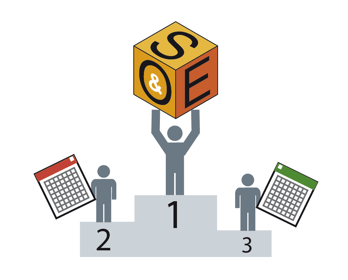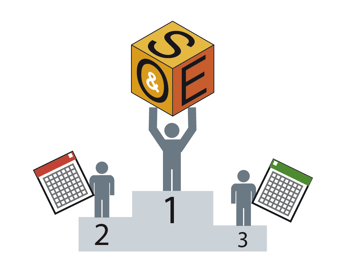5 Ways S&OE Can Impact Modern Manufacturing
Brian Hoey - April 11, 2019

 Most businesses in the manufacturing sphere have some form of sales and operations planning (S&OP) workflow that covers the monthly or quarterly timetable that’s often left unplanned in longer term business goals. In the Industry 4.0 era, a newer, even more granular level of planning has emerged to supplement S&OP by covering the daily, weekly, and monthly supply chain activities that might otherwise go without any cohesive planning structure. The name of this new level of planning? Sales and operations execution, or S&OE.
Most businesses in the manufacturing sphere have some form of sales and operations planning (S&OP) workflow that covers the monthly or quarterly timetable that’s often left unplanned in longer term business goals. In the Industry 4.0 era, a newer, even more granular level of planning has emerged to supplement S&OP by covering the daily, weekly, and monthly supply chain activities that might otherwise go without any cohesive planning structure. The name of this new level of planning? Sales and operations execution, or S&OE.
Possibly some of you have heard of S&OE, or have perhaps even attempted to implement S&OE workflows into your existing processes, but across the industry it isn’t necessarily a widely understood or widely adopted approach. This is in part because it’s a relatively new phenomenon—its name was only coined by Gartner a few years ago and its successful implementation depends on emerging Industry 4.0 technologies that are only just now becoming more commonplace—but it’s also no doubt due to a relative lack of understanding about what the impact of such a strategy might be. Luckily, we’re here to help by offering an overview of the effects that S&OE might have on the world of manufacturing going forward.
1. Smarter Inventory Management
S&OE as a process begins with data. Supply chain managers integrate real time demand sensing into their existing production data streams in order to create a legible picture of daily and weekly supply chain operations. S&OE planners then use that picture of supply chain operations to tweak daily, weekly, and monthly supply chain operations to keep longer term organizational goals on track. This typically takes the form of making small adjustments to inventory planning and transport routing—two business functions that be modified fairly easily as expectations change and evolve. When it comes to inventory management in particular, S&OE’s job is to make sure that any sudden dip in demand for a particular product is being met by a corresponding decrease (or lack of increase) in stock levels for that product. In this way, planners are able to stave off the kinds of longer-term disruptions that might occur from piles of unsold stock accumulating in a warehouse.
2. Improved Production Visibility
Now, even the simple act of adjusting inventory levels that we described above wouldn’t be possible in an environment with limited visibility. We noted above that S&OE workflows are a perfect fit for Industry 4.0-enabled (or at least highly digitized) production environments, and it’s for precisely this reason: planners need access to real-time data from multiple touchpoints on the value chain. As businesses adopt S&OE workflows, then, there will be a huge organizational push to reach the level of visibility at which S&OE can actually make a meaningful impact. From there, these new planning paradigms can actually improve visibility in turn. How? By providing planners operating with longer timescales with a clear snapshot of supply chain operations on a weekly or monthly level. In this way, organizations can gain a stronger sense of how likely they are to meet their longer term goals and get insight into how they might adjust those goals and expectations going forward. Like the effect outlined above, this prevents the kind of long term disconnect between expectations and reality that can quickly prove costly.
3. More Dynamic Transport Planning
In the same way that S&OE seeks to improve inventory management in order to keep longer-term plans on track, it also performs similar functions for transport planning flows. Rather than relying on static transport routes that don’t account for changing conditions, planners working with real-time logistics data can ensure that anything leaving the warehouse is doing so at the optimal moment. If, for instance, you can see that your production flows are going to experience a slowdown, you can attempt to match up your new projected inventory levels with your demand expectations in such a way as to answer mission critical questions: should you delay a planned shipment in order to have a full truck load? Should you take advantage of a dip in demand to bundle your original shipment differently? Will a milk run or LTL help to take pressure off your production flow in a way that still squares with real demand levels? As you gain answers to these questions, you can create dynamic transport planning choices accordingly. And this doesn’t have to by the sole province of S&OE—rather, this mindset can be applied across your organization in order to rely less on static, recurring actions and focus instead on how to dynamically time things like shipments and production processes to optimize value.
4. Increased Analytics Integration
By this point we’ve spoken a lot about the various data streams that make S&OE possible, and within the context of this short-term supply chain management process that data is already extremely valuable. But since that data has to be collected and centralized anyway, there’s no reason for manufacturers not to make the most of it. How can they do that? By using advanced analytics to turn it into improved forecasts and prescriptive insights for potential process improvements. Not only can improved demand forecasts actually create a positive feedback loop whereby S&OE flows become more effective, they can help you to create better long term plans by offering you a level of confidence that would have been difficult to come by previously.
5. Reduced Costs
Now, what’s the one thing that all of these areas of potential impact have in common? That’s right, they offer important opportunities for short- and long-term cost savings. In each of the effects we described above, S&OE helped to increase efficiency and eliminate disconnect between future plans and present realities. Not only can that result in money saved in the short run (due to reduced inventory and shipping costs resulting from more efficient supply chain management), it can also make your business healthier going forward. As you skirt around the kinds of daily or weekly disruptions whose effects can compound over time, you can also avoid the quarterly or yearly disruptions that can completely derail your business plans. The level of visibility required by these processes can be significant, but in the end it has the potential to pay off in a big way.
LATEST POSTS
- Understand Circular Economy in The Manufacturing Industry
- How Can Industry 4.0 IT Integration Be Achieved Smoothly?
- The Significance of Order Sequencing in Discrete Manufacturing
- How to improve your Supply Chain Management: The Power of Control Towers
- Optimizing Human Resource Scheduling in Manufacturing: A Technological Approach


